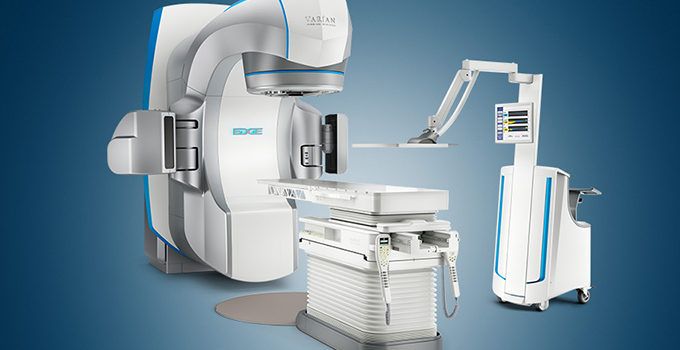

Next Generation Radiation Treatment Comes To PNI
by Zara Jethani
While many intracranial tumors can be completely removed with surgery, others require additional treatments including chemotherapy, immuno-therapy and/or radiotherapy. Pacific Neuroscience Institute neurosurgeons work closely with radiation oncology colleagues in the treatment of these brain, skull base and pituitary tumors. Precision delivery of radiation with either Stereotactic Radiosurgery (SRS) or Stereotactic Radiotherapy (SRT) is commonly used for many such tumors to halt tumor growth.
The Vasek Polak Radiation Oncology Department at Providence Saint John’s Health Center is the first center in Southern California to have the state-of-the-art Edge® system from Varian Medical Systems for cancer treatment. The equipment adds to the wide range of cancer-killing technology available at Providence Saint John’s and the Saint John’s Cancer Institute. Dr. Robert Wollman and Dr. Lisa Chaiken, our radiation oncologists, treat patients with a diverse range of cancers and tumors. Radiosurgery plans are developed together with neurosurgeon Dr. Garni Barkhoudarian and medical physicist Dr. Randal Slates.

The technology represents a significant advance in radiation oncology that allows for more precise targeting of tumors while sparing healthy surrounding tissue from damage. ” The Edge linear accelerator system allows for much faster and more precise treatment sessions, which means better outcomes and a less stressful experience for patients”, says Robert Wollman, MD, medical director of the department of radiation oncology at Providence Saint John’s.
“We get patients who are receiving stereotatactic radiation treatments on and off the treatment machine much quicker,” he says. “Speed is important both for patient comfort and for accuracy. The longer people are on the table, the greater the chance of movement—all of which adds imprecision. With this new technology, you are on target and you can have narrow margins on the areas that you’re trying to treat.”
The Edge is equipped with real-time motion management, called Vision RT, which does not require the use of head frames or extra doses of X-rays to ensure accuracy. The operator can ensure a patient is set up in the correct position before radiation therapy and track any tiny movement during the treatment via real-time feedback.
“With Vision RT, it allows us to do noninvasive targeting and without added X-rays,” he says. “It cuts down on unnecessary radiation and unnecessary surgery.”
Older technologies like Cyber Knife and Gamma Knife are often encumbered with the need for surgical fixation, X-ray targeting and outdated software that makes them more invasive, slower and more complicated to use, Dr. Wollman notes. The technology in the Edge system is fully integrated. This means it is safer and faster.
“One of the great things about having a machine with everything built in is it works together seamlessly, and there are far fewer logistical challenges that make it difficult for the operator and can keep a patient lying on the machine longer,” he says.
For more information on the Varian Edge or other radiation therapies, please visit our Radiosurgery & Radiation Oncology page.
Adapted from the original press release issued by Providence Saint John’s Health Center.
About the Author

Zara Jethani
Zara is the marketing director at Pacific Neuroscience Institute. Her background is in molecular genetics research and healthcare marketing. In addition, she is a graphic designer with more than 20 years experience in the healthcare, education and entertainment industries.
Last updated: April 3rd, 2020